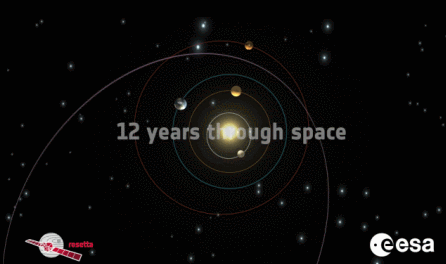So you are thinking who are these people and why should
we be interested in their story. Well firstly, they are not people. Maybe
that’s what makes this an interesting story.
Humans have always been fascinated by space. We have wondered about our own solar system, Galaxy, the Universe and are constantly
looking to explore. With our curiosity and the technology that we now posses, we
send missions to nearby objects.
Rossetta and Philae were sent on one such mission to the
Comet 67P a.k.a Churyumov–Gerasimenko. Rosetta being the spacecraft that would make
the journey to the comet and orbit around it; and Philae being the probe that
would land on this comet. The plan was for Rosetta to carry Philae near the comet,
and drop it such that it lands at the desired site on 67P. Then Philae could do
some science on the surface of this comet and communicate with Rosetta, which
in turn would communicate back to earth. This is the first mission to ever land
a probe on a comet.
Smaller objects like comets and asteroids are interesting
bodies, as they give us insight to the origins of our solar system; and
possibly, even answer key questions to origins of life.
This mission started in 1996 and the launch spacecraft was on
March 2004, and Philae was able to land on Comet 67P on November 2014. That’s
right, this trip took a decade. It wasn’t a linear trip from Earth to 67P. On
its way, Rosetta had to perform few gravity assist flyby’s; one with Mars and
rest with couple of asteroids. Their journey itself is epic, and highlights the
amount of effort it takes for space travel.
So on reaching closer to Comet 67P, Rosetta (carrying Philae
with it) started orbiting the comet for few days to align it to make the drop.
Keep in mind that, Comet 67P travels at 135,000 Km / hr. Eventually, Rosetta
had to let go of Philae so it could land. However things do go wrong, and
Philae was not able to secure itself to the original site as planned on the comet.
In fact, due to 67P’s speed and the drop velocity of the probe, Philae bounced
4 times on the surface and landed on the side that was facing away from the
Sun. Damaged by the landing impact and unable to charge its solar powered batteries,
Philae did send back signals and data it could collect from 67P until its
primary batteries lasted, and then went into silent-hibernation, unable to
communicate with Rosetta.
Although they were just a spacecraft and a probe, but they had been together for a decade, making a journey into the unknown, and in the very next
moment there was total silence, no contact whatsoever. Can imagine how that
would feel if they were real people.
How would the scientists who worked on this mission have felt?
How would the scientists who worked on this mission have felt?
So there it was, Rosetta kept orbiting Comet 67P, searching
for signs of Philae. Those working on this mission had concluded that Philae
would never contact back, mainly due to its impact upon landing. However, few
months later, in June 2015, Philae did make contact with Rosetta, as it faced
the sun and charged its batteries. There were only 8 intermittent contacts
though from June to July, before Philae finally stopped communicating.
And during its time of activity, Philae was able to do some
science and found 16 organic compounds, few of them being acetamide, acetone, methyl isocyanate and proionaldehyde. Out of
which the last one is a compound found in our DNA. There were also traces of
molecular oxygen (which is very rare to find in space) and heavy water (has
isotope of Hydrogen i.e Deuterium).
After sending all these interesting information Philae went
silent and hasn’t spoken since. Rosetta
is still orbiting Comet 67P from a distance of 170 to 200 km from its surface. This is how the Comet 67 looks when viewed by Rosetta; or click here.
Well the mission funding will be over soon, and the question
is what should be done with Rosetta. The plan for now is, it will continue to
orbit 67P and gather information. And soon, for its end of life, would be made
to land on the comet; which wasn’t the original part of the plan. Things are
being worked out as to how to make a soft landing and not crash it.
So the final resting place for Rosetta would be where Philae
is, on the surface of Comet 67P. Who knows, how the re-union would be.
This is why I love Astronomy. There are stories, there is
wonder and there are possibilities. It’s one kind of poetry.

.gif)
No comments:
Post a Comment